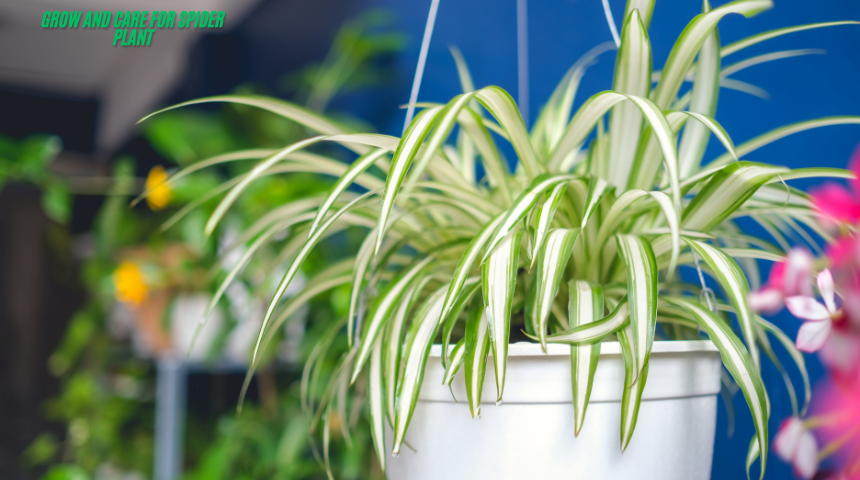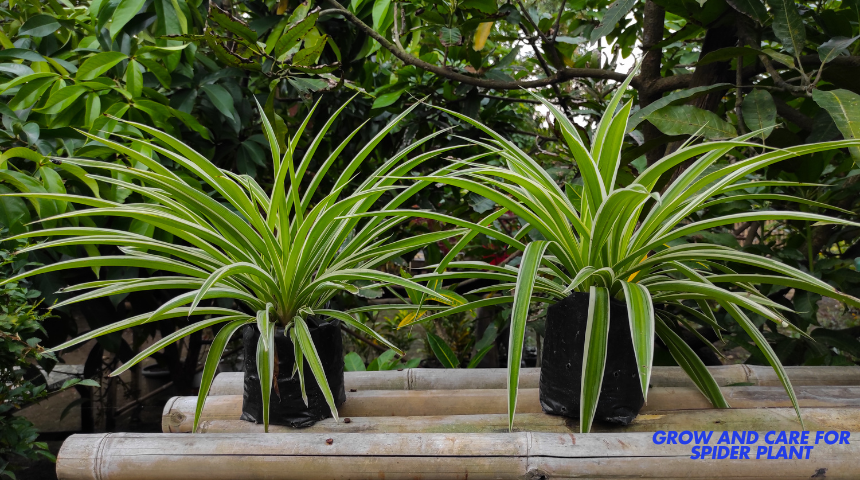How to grow and care for spider plant is simple and rewarding. Spider plants are among the easiest houseplants to grow and care for. I enjoy their vibrant green and white-striped leaves that brighten up any space.
This hardy plant adapts well to different environments, making it perfect for beginners. It also improves air quality, which adds health benefits to its beauty. Growing a spider plant doesn’t require much time or effort.
With proper care, it thrives indoors and produces little plantlets, often called “spider pups.” These pups can grow into new plants, making propagation fun. Its forgiving nature tolerates occasional neglect.
I’ve found it to be a delightful plant for my home. Let me guide you on how to grow and care for this charming plant.
How To Grow And Care For Spider Plant?
Growing and caring for a spider plant is simple. I choose a pot with good drainage. I use well-draining soil to prevent root rot. I place the plant in bright, indirect light. Direct sunlight can burn its leaves.
I water it when the topsoil feels dry. Overwatering harms the roots, so I avoid it. I fertilize once a month during the growing season. A balanced liquid fertilizer works well.
I trim dead leaves to keep them healthy. Spider plants also like slightly humid air. I mist the leaves occasionally if the air is dry. With these steps, the plant thrives beautifully.
Growing From Seeds
- Collect mature seeds from spider plant flowers.
- Use a well-draining seed-starting mix for planting.
- Plant seeds about 1/4 inch deep and cover lightly with soil.
- Keep the soil moist but not soggy during germination.
- Place the container in bright, indirect light.
- Maintain temperatures around 70°F (21°C) for better germination.
- Seeds may take 2–3 weeks to sprout.
- Transplant seedlings into individual pots once they grow a few leaves.
- Be patient, as growing from seeds takes more time than propagation.

Growing In Pots
- Choose a pot with drainage holes to prevent waterlogging.
- Use well-draining soil, such as a mix of potting soil and perlite.
- Water the plant when the topsoil feels dry.
- Place the pot in a spot with bright, indirect light.
- Fertilize monthly during the growing season for healthy foliage.
- Repot the plant every 1–2 years to refresh the soil and avoid root-bound issues.
- Keep the pot in a stable environment with moderate humidity.
- Rotate the pot occasionally for even growth.
Choosing The Right Environment
Spider plants love bright, indirect sunlight. I place mine near a window with filtered light to help it thrive. Avoid direct sunlight, as it can scorch the leaves and cause discoloration. They also prefer moderate temperatures, between 65–75°F (18–24°C).
Extreme heat or cold stresses the plant, so I avoid placing it near heaters or air conditioners. I’ve noticed they grow well in rooms with natural light. However, they can adapt to lower light conditions too. Proper lighting ensures healthy leaves and faster growth.
I also avoid sudden temperature changes, as it affects their growth. Providing a consistent environment keeps my spider plant happy.
Soil And Pot Selection
Spider plants need well-draining soil to prevent root rot. I use a light potting mix with a bit of sand or perlite for better drainage. Avoid heavy soils that retain too much water. A pot with drainage holes is essential to let excess water escape.
I prefer using medium-sized pots that allow room for the roots to grow. Overcrowding the roots can stunt its growth, so I report it every couple of years.
Clay pots are a good choice because they allow the soil to breathe. I also avoid decorative pots without drainage. Healthy soil and the right pot ensure steady growth for my plant.
Watering Needs
Spider plants thrive with regular watering but dislike soggy soil. I water mine when the top inch of the soil feels dry to the touch. Overwatering can lead to root rot, so I’m careful not to let water sit in the pot.
During warmer months, I water more frequently as the plant grows faster. In winter, the plant’s water needs decrease, so I adjust accordingly. It’s important to use lukewarm water to avoid shocking the roots.

I always check for signs of underwatering, like wilting leaves. With consistent care, spider plants maintain lush, healthy foliage.
Fertilizing Tips
Spider plants don’t need heavy feeding to stay healthy. I fertilize mine once a month during spring and summer. A balanced liquid fertilizer works best for these plants. I dilute the fertilizer to half-strength to avoid burning the roots.
Over-fertilizing can cause the tips of the leaves to brown, so I always use it sparingly. During fall and winter, I stop fertilizing since the plant’s growth slows.
Organic fertilizers like compost tea also work well for spider plants. Regular feeding helps maintain their vibrant green color. Healthy nutrition encourages strong, beautiful leaves.
Pruning And Maintenance
Pruning helps keep spider plants looking fresh and neat. I trim away dead, yellow, or brown leaves with sharp scissors. Removing these leaves prevents pests and encourages new growth. If the plant becomes too large, I also cut back the older leaves.
Pruning regularly improves the plant’s overall shape. I check for any dust on the leaves and wipe them gently with a damp cloth. Clean leaves allow the plant to photosynthesize better. Proper maintenance keeps my spider plant vibrant and healthy.
Managing Pests And Problems
- Spider mites: Cause tiny yellow spots on leaves; treat with insecticidal soap.
- Aphids: Found on new growth; wash off with water or use neem oil.
- Mealybugs: Appear as white, cottony patches; remove them manually with a cotton swab dipped in alcohol.
- Root rot: Caused by overwatering; ensure proper drainage and avoid soggy soil.
- Brown leaf tips: Result from fluoride or chlorine in water; use distilled or rainwater.
- Powdery mildew: Develops in high humidity; improve air circulation and avoid overhead watering.
- Scale insects: Appear as brown bumps on stems; scrape off gently and apply horticultural oil.
Propagation
Spider plants produce little plantlets or “pups” on long stems. I love propagating these pups to grow new plants. First, I gently remove a pup from the mother plant. Then, I place it in a small pot with fresh soil. Alternatively, I root it in water before planting.
Within a few weeks, the pup develops roots and starts growing. Propagation is an easy way to expand my collection or share plants with friends. It’s also a satisfying process to watch them grow into full plants.
Benefits Of Spider Plants
Spider plants are more than just decorative. They purify the air by removing harmful toxins like carbon monoxide and formaldehyde. This makes them ideal for homes and offices. Their cascading leaves add charm to any room.
I’ve found they help reduce stress and create a calming atmosphere. Placing one near a window enhances natural light in the room. Their air-cleaning abilities and low-maintenance nature make them one of my favorite plants to grow.
Improves Air Quality
Spider plants are excellent at purifying indoor air. They remove harmful toxins like carbon monoxide, formaldehyde, and benzene. I find this makes them ideal for improving home and office environments.
Boosts Humidity Levels
These plants release moisture into the air, which helps maintain better humidity indoors. This is especially beneficial in dry climates or during winter when indoor heating reduces air moisture.
Reduces Stress and Enhances Mood
Having a spider plant around creates a calming atmosphere. I’ve noticed it helps reduce stress and boosts overall well-being. Greenery often makes a space feel more inviting and serene.
Low Maintenance
Spider plants are forgiving and thrive with minimal care. Their adaptability makes them perfect for busy lifestyles or beginners who are new to houseplants.
Propagates Easily
Spider plants produce pups, or small offshoots, that can be propagated effortlessly. I enjoy watching these little plantlets grow, making great gifts or additions to other rooms.

Aesthetic Appeal
The cascading leaves of spider plants add beauty and charm to any space. Whether in hanging baskets or decorative pots, they elevate the look of a room with their lush greenery.
How Do You Care For A Spider Plant Indoors?
- Please place it in bright, indirect sunlight.
- Water it when the top inch of soil feels dry.
- Use well-draining soil and a pot with drainage holes.
- Avoid overwatering to prevent root rot.
- Maintain room temperatures between 65–75°F (18–24°C).
How Do You Make A Spider Plant Happy?
- Provide moderate humidity by misting occasionally.
- Fertilize monthly during spring and summer.
- Trim dead or yellowing leaves regularly.
- Please keep it away from direct sunlight to avoid leaf scorch.
- Use distilled or filtered water to prevent fluoride buildup.
Where Is The Best Place To Put A Spider Plant?
- Near a window with filtered, indirect light.
- In rooms with natural light, like kitchens or bathrooms.
- Away from heat sources like radiators or air conditioners.
- In hanging baskets to showcase its cascading leaves.
- In spots with consistent temperatures and humidity.
FAQ
How often should I water my spider plant?
Water it when the top inch of soil feels dry. Avoid overwatering to prevent root rot.
Can spider plants grow in low light?
Yes, but they grow best in bright, indirect sunlight. Low light may slow their growth.
Why do the tips of my spider plant’s leaves turn brown?
Brown tips often result from overwatering, low humidity, or fluoride in water. Use distilled water and mist the leaves.
How do I propagate spider plants?
Cut off the small pups from the mother plant. Plant them in the soil or root them in water first.
Do spider plants need fertilizer?
Yes, feed them monthly during spring and summer. Use a balanced liquid fertilizer for best results.
Conclusion
Growing and caring for a spider plant is incredibly rewarding. It’s one of the easiest plants to take care of, making it perfect for beginners. I love how it thrives with minimal effort and adds a touch of greenery to any space.
With the right light, proper watering, and occasional feeding, your spider plant will flourish. Remember to prune it regularly to keep it looking fresh. Don’t worry if you don’t have a green thumb — spider plants are pretty forgiving.
Propagation is also fun and simple, so you can grow even more plants. I enjoy how these plants purify the air and create a calming atmosphere.
If you follow these basic care steps, you’ll have a healthy, vibrant spider plant. I’ve seen them thrive in many homes, and I’m sure yours will too. Happy gardening!



